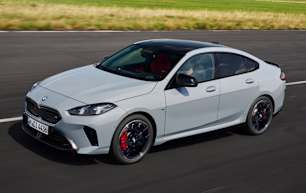The RC350 F Sport is actually pretty good to drive – so long as you understand what it’s about.
Think of it more as a comfortable cruiser than a sports car and you’ll forgive it for some of its shortcomings. Yep, it is that relaxing to drive.
While the F Sport’s suspension (independent double-wishbone front and multi-link rear axles with adaptive dampers) does have a sports tune, it still serves up a comfortable ride on most surfaces.
Naturally you can play with the five drive modes (Eco, Normal, S, S+ and Custom) on hand to increase its stiffness and therefore improve handling, but the difference between soft and ‘hard’ is negligible, so don’t bother.
Either way, the F Sport does have a noticeable habit of picking up sharper road edges, such as nasty potholes, and it's particularly prevalent at the rear. That said, it doesn’t detract from its luxuriousness all that much.
Where the sportiness really comes to the fore, though, is via the F Sport’s electric power steering system, which has a variable ratio.
As well-weighted as this set-up is as standard, you’ll find it hard to forget how sharp it is on turn-in. Among several factors at play, the obvious one is the F Sport’s rear-wheel steering system, which is better executed than most.
This technology turns the front wheels in the opposite direction to the rears at lower speeds but in the same orientation at higher velocities.
The result of the former? A mid-size coupe that feels like it has a short wheelbase, with the improved manoeuvrability especially noticeable in car parks. Conversely, the latter lends itself to greater stability when you need it.
And it’s a good thing it is the way it is, because the RC 350 F Sport has a kerb weight of 1740kg, which is not exactly sports-car light. This heft is a felt when cornering hard, even though body control is pretty strong overall.
Handling performance is also enhanced by the rear Torsen limited-slip differential, which helps improve grip upon corner exit, at which point the RC 350 gets to show off its straight-line abilities.
The V6 engine is buttery-smooth, but you really need to stick the boot in to fully enjoy it, with it only really starting to come alive when engine speeds are above 3000rpm.
That said, it’s easy to appreciate this character trait around town, where the RC 350 is truly unfazed. Take it onto the open road, though, and acceleration is more than pleasing.
The automatic transmission is a great dancing partner here, serving up delightfully smooth gear changes. It’s also surprisingly responsive, perhaps too responsive, as it can be quite fussy in city traffic, shuffling up and down ratios in quick succession.
Biggest gripe, however, is the digitally enhanced sound the RC 350 produces. Sitting inside, the noise being pumped in is satisfying, but you can’t help but acknowledge the aural deception at play.


















































